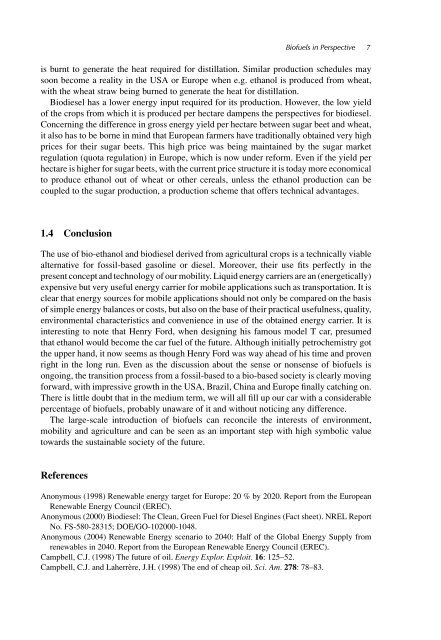Biofuels in Perspective
Biofuels in Perspective
Biofuels in Perspective
You also want an ePaper? Increase the reach of your titles
YUMPU automatically turns print PDFs into web optimized ePapers that Google loves.
<strong>Biofuels</strong> <strong>in</strong> <strong>Perspective</strong> 7<br />
is burnt to generate the heat required for distillation. Similar production schedules may<br />
soon become a reality <strong>in</strong> the USA or Europe when e.g. ethanol is produced from wheat,<br />
with the wheat straw be<strong>in</strong>g burned to generate the heat for distillation.<br />
Biodiesel has a lower energy <strong>in</strong>put required for its production. However, the low yield<br />
of the crops from which it is produced per hectare dampens the perspectives for biodiesel.<br />
Concern<strong>in</strong>g the difference <strong>in</strong> gross energy yield per hectare between sugar beet and wheat,<br />
it also has to be borne <strong>in</strong> m<strong>in</strong>d that European farmers have traditionally obta<strong>in</strong>ed very high<br />
prices for their sugar beets. This high price was be<strong>in</strong>g ma<strong>in</strong>ta<strong>in</strong>ed by the sugar market<br />
regulation (quota regulation) <strong>in</strong> Europe, which is now under reform. Even if the yield per<br />
hectare is higher for sugar beets, with the current price structure it is today more economical<br />
to produce ethanol out of wheat or other cereals, unless the ethanol production can be<br />
coupled to the sugar production, a production scheme that offers technical advantages.<br />
1.4 Conclusion<br />
The use of bio-ethanol and biodiesel derived from agricultural crops is a technically viable<br />
alternative for fossil-based gasol<strong>in</strong>e or diesel. Moreover, their use fits perfectly <strong>in</strong> the<br />
present concept and technology of our mobility. Liquid energy carriers are an (energetically)<br />
expensive but very useful energy carrier for mobile applications such as transportation. It is<br />
clear that energy sources for mobile applications should not only be compared on the basis<br />
of simple energy balances or costs, but also on the base of their practical usefulness, quality,<br />
environmental characteristics and convenience <strong>in</strong> use of the obta<strong>in</strong>ed energy carrier. It is<br />
<strong>in</strong>terest<strong>in</strong>g to note that Henry Ford, when design<strong>in</strong>g his famous model T car, presumed<br />
that ethanol would become the car fuel of the future. Although <strong>in</strong>itially petrochemistry got<br />
the upper hand, it now seems as though Henry Ford was way ahead of his time and proven<br />
right <strong>in</strong> the long run. Even as the discussion about the sense or nonsense of biofuels is<br />
ongo<strong>in</strong>g, the transition process from a fossil-based to a bio-based society is clearly mov<strong>in</strong>g<br />
forward, with impressive growth <strong>in</strong> the USA, Brazil, Ch<strong>in</strong>a and Europe f<strong>in</strong>ally catch<strong>in</strong>g on.<br />
There is little doubt that <strong>in</strong> the medium term, we will all fill up our car with a considerable<br />
percentage of biofuels, probably unaware of it and without notic<strong>in</strong>g any difference.<br />
The large-scale <strong>in</strong>troduction of biofuels can reconcile the <strong>in</strong>terests of environment,<br />
mobility and agriculture and can be seen as an important step with high symbolic value<br />
towards the susta<strong>in</strong>able society of the future.<br />
References<br />
Anonymous (1998) Renewable energy target for Europe: 20 % by 2020. Report from the European<br />
Renewable Energy Council (EREC).<br />
Anonymous (2000) Biodiesel: The Clean, Green Fuel for Diesel Eng<strong>in</strong>es (Fact sheet). NREL Report<br />
No. FS-580-28315; DOE/GO-102000-1048.<br />
Anonymous (2004) Renewable Energy scenario to 2040: Half of the Global Energy Supply from<br />
renewables <strong>in</strong> 2040. Report from the European Renewable Energy Council (EREC).<br />
Campbell, C.J. (1998) The future of oil. Energy Explor. Exploit. 16: 125–52.<br />
Campbell, C.J. and Laherrère, J.H. (1998) The end of cheap oil. Sci. Am. 278: 78–83.








